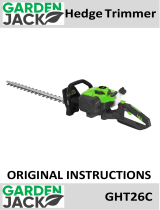POWXG3026 EN
Copyright © 2021 VARO P a g e | 9 www.varo.com
6.2 Chain saw
▪ DO NOT operate a chain saw with one hand! Serious injury to the operator, helpers,
bystanders, or any combination of these persons may result from one-handed operation. A
chain saw is intended for two-handed use.
▪ DO NOT operate a chain saw when you are fatigued, under the influence of drugs, alcohol
or medication.
▪ Use safety footwear, snug-fitting clothing, protective gloves, and eye, hearing and head
protection devices.
▪ Use caution when handling fuel. To avoid fire, move the chain saw at least 10 feet (3 m)
from the fuelling point before starting the engine.
▪ DO NOT allow other persons to be near when starting or cutting with the chain saw. Keep
bystanders and animals out of the work area.
▪ DO NOT start cutting until you have a clear work area, secure footing, and a planned
retreat path from the falling tree.
▪ Keep all parts of your body away from the saw chain when the engine is running.
▪ Before you start the engine, make sure that the saw chain is not contacting anything.
▪ Carry the chain saw with the engine stopped, the guide bar and saw chain to the rear, and
the muffler away from your body.
▪ DO NOT operate a chain saw that is damaged, improperly adjusted, or not completely and
securely assembled. Be sure that the saw chain stops moving when the throttle control
trigger is released.
▪ Shut off the engine before setting the chain saw down.
▪ Use extreme caution when cutting small size brush and saplings because slender material
may catch the saw chain and be whipped toward you or pull you off balance.
▪ When cutting a limb that is under tension, be alert for spring back so that you will not be
struck when the tension in the wood fibres is released.
▪ Keep the handles dry, clean, and free of oil or fuel mixture.
▪ Operate the chain saw only in well-ventilated areas.
▪ DO NOT operate a chain saw in a tree unless you have been specifically trained to do so.
▪ All chain saw service, other than the items listed in the user manual safety and
maintenance instructions, should be performed by competent chain saw service
personnel.
▪ When transporting your chain saw, use the appropriate guide bar scabbard.
▪ DO NOT operate your chain saw near or around flammable liquids or gases whether in or
out of doors. An explosion and/or fire may result.
▪ Do not fill fuel tank, oil tank or lubricate when the engine is running.
▪ USE THE RIGHT TOOL: Cut wood only. Do not use the chain saw for purposes for which
it was not intended. For example, do not use the chain saw for cutting plastic, masonry, or
non-building materials.
▪ The first time user should have practical instruction in the use of chainsaw and the
protective equipment from an experienced operator.
▪ Do not attempt to hold the saw with one hand only. You cannot control reactive forces
and you may lose control of the saw, which can result in the skating or bouncing of the bar
and chain along the limb or log.
▪ Never run the chainsaw indoors. Your chainsaw produces poisonous exhaust as soon as
the combustible engine is started, which may be colourless and odourless. To use this
product can generate dust, mists and fumes containing chemicals known to cause
reproductive harm. Be aware of harmful dust, mist (such as saw dust or oil mist from chain
lubrication) and protect yourself properly.
▪ Wear gloves and keep your hand warm. Prolonged use of chainsaws exposing the
operator to vibrations may produce whitefinger disease. In order to reduce the risk of
whitefinger disease, please wear gloves and keep your hand warm. If any of the
whitefinger symptoms appear, seek medical advice immediately.





















